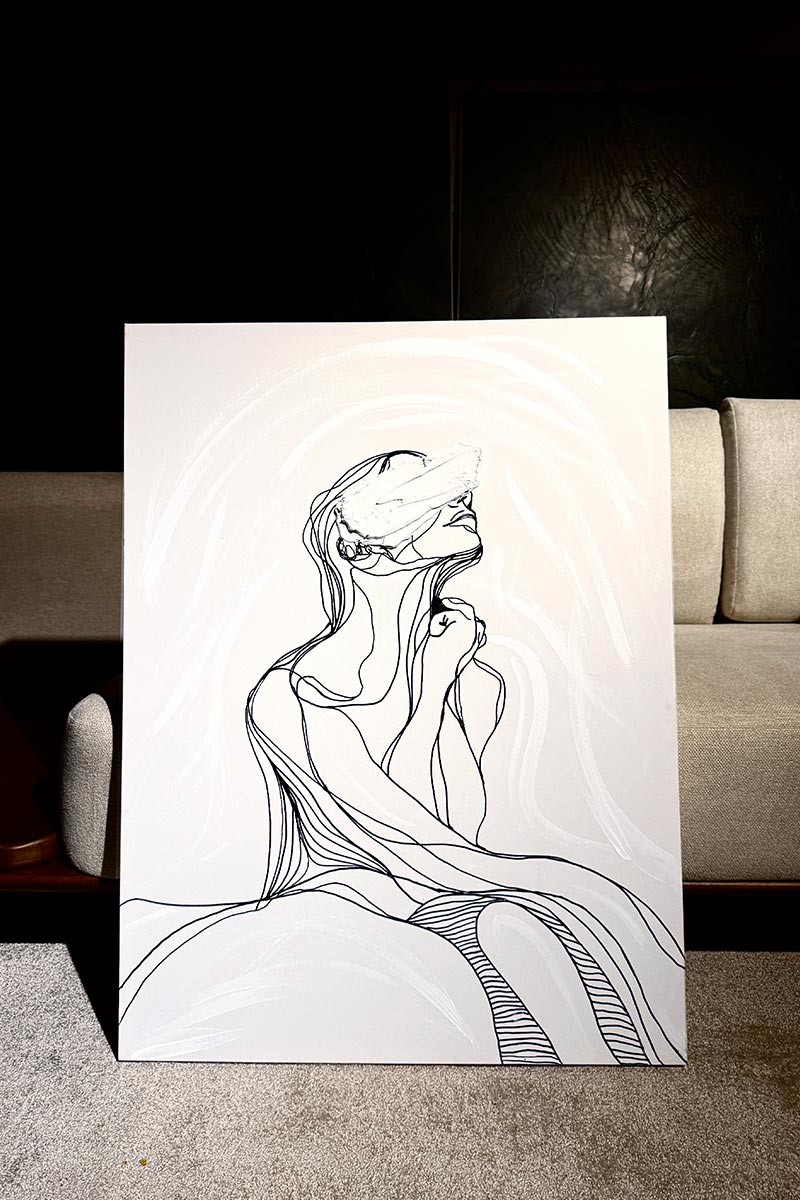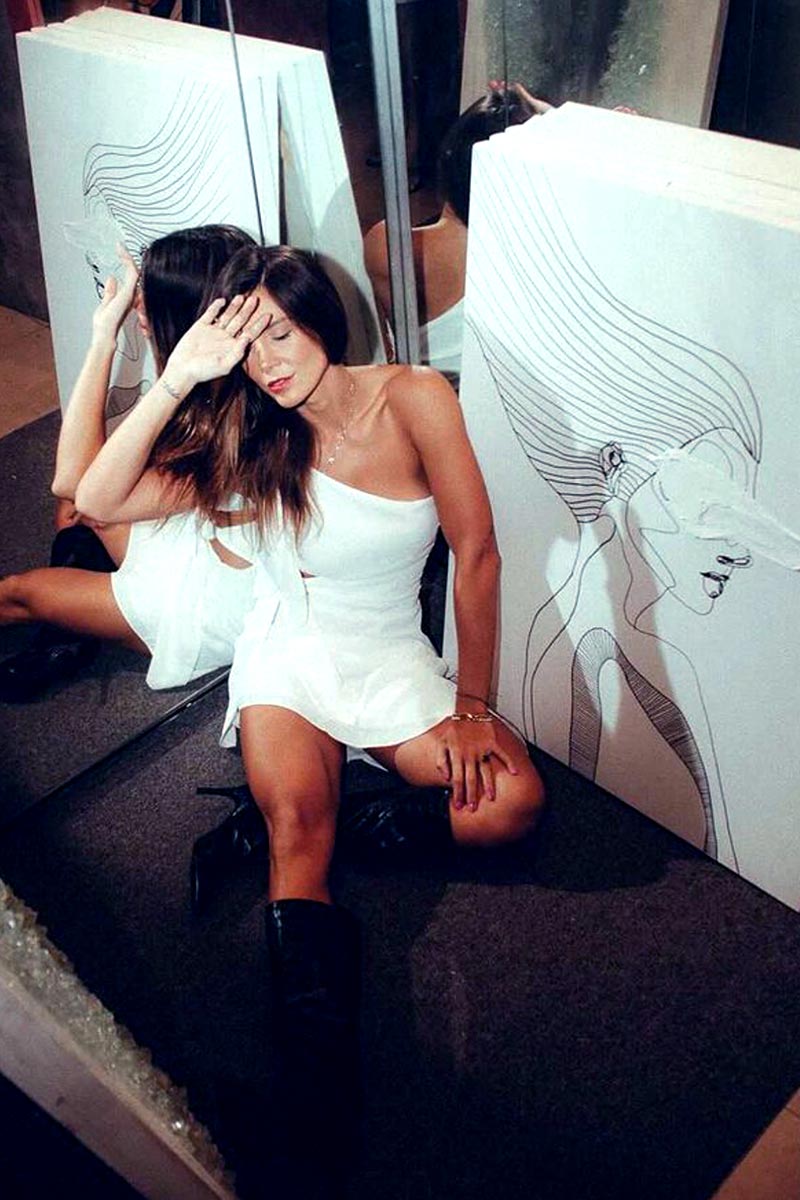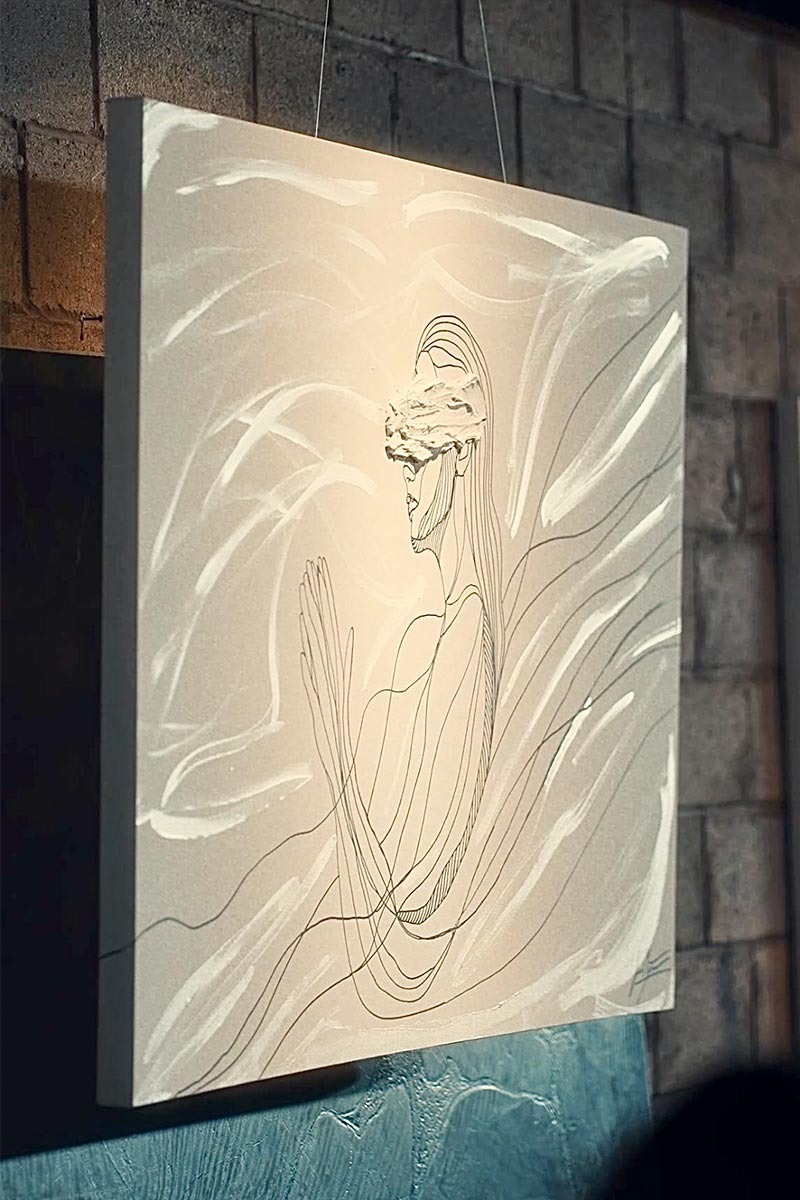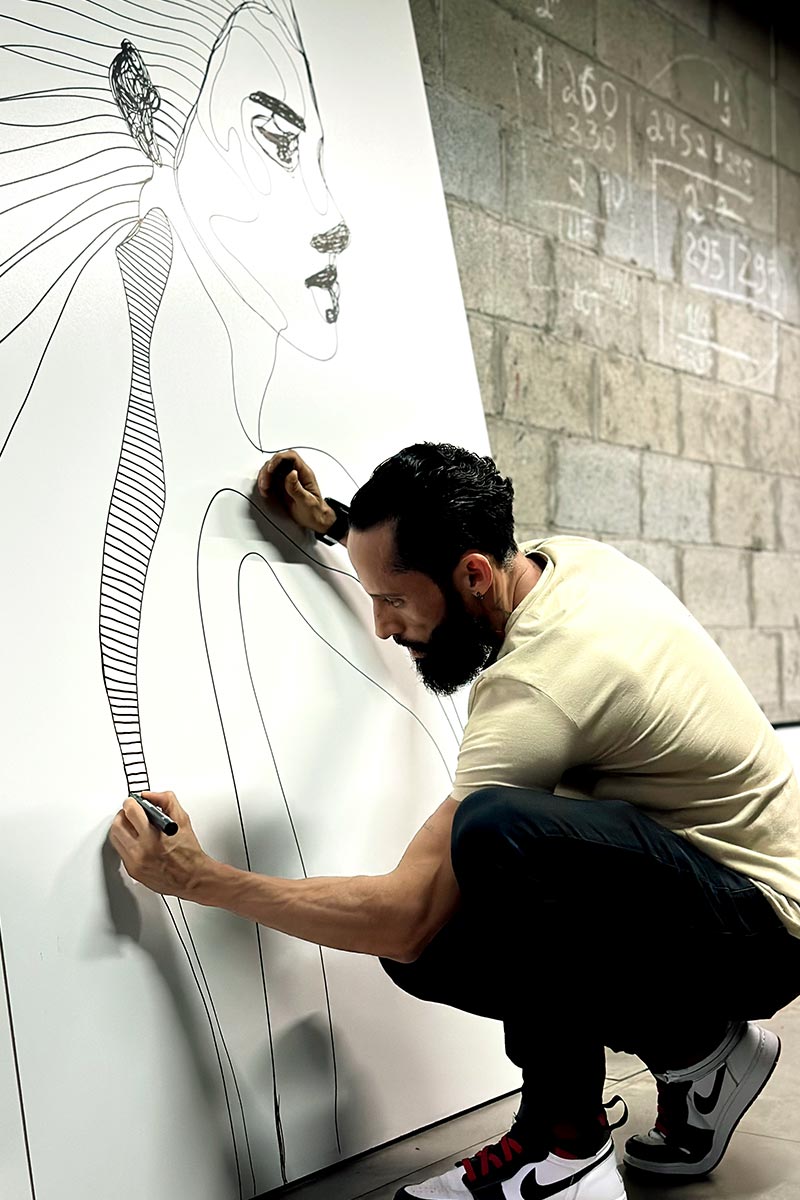Traces
“A vida deixa marcas que nunca se apagam.”
“Life leaves marks that never fade.”
生命留下的痕迹,永不褪去。
Série criada em 2017
Premiações: Estados Unidos, Viena
“Traces” foi a primeira série da trajetória de Juca Máximo, onde optou por não desenhar o corpo como representação visual, mas como vestígio — feito apenas pelas marcas que a vida deixou. Aqui, a figura humana não é construída por formas externas, mas pelas linhas que registram dores e trajetórias.
Não se trata da dor como sofrimento, mas como elemento inevitável e essencial da existência — como afirmaram os grandes pensadores materialistas. Schopenhauer, Spinoza, Nietzsche: todos reconhecem a dor como matéria-prima do existir. Por isso, Juca traz leveza à dor. O fundo branco da tela, o traço fino e contínuo da caneta e o empasto espesso sobre os olhos revelam que a dor é vivida, mas não necessariamente exposta. Existe beleza em tudo — especialmente nas cicatrizes.
As linhas, nunca retas, simbolizam os movimentos que a vida oferece. Suas espessuras revelam as intensidades com que cada instante é sentido. Distâncias, curvas e interrupções não desenham um corpo, mas um percurso — um verdadeiro mapa emocional da existência.
Se em Absence o observador é convidado a fechar os olhos e mergulhar dentro de si, em Traces a proposta vai além:
“Não olhe para nada — nem para o que está a um palmo de você, nem para o que está dentro de você. Nem no passado, nem no futuro. Se você conseguir fazer isso, vai se sentir flutuando. É como olhar para tudo e nada ao mesmo tempo — um espaço branco, pronto para ser reconstruído com novas marcas.”
Fase I – Branco sobre Branco
Nesta fase inaugural, todas as obras são monocromáticas. O corpo é delineado apenas com linhas pretas sobre fundo branco, enquanto os olhos são cobertos por empastos brancos, indicando que a dor está presente, mas silenciosa — ela molda, mas não define.
Series created in 2017
Awards: United States, Vienna
“Traces” was the first series in Juca Máximo’s artistic journey, where he chose not to draw the body as a visual representation, but as a trace — shaped only by the marks life has left behind. Here, the human figure is not constructed through external forms, but through lines that register pain and personal paths.
This is not about pain as suffering, but as an inevitable and essential element of existence — as affirmed by great materialist philosophers. Schopenhauer, Spinoza, Nietzsche: all recognized pain as the raw material of being. That is why Juca brings lightness to pain. The white background of the canvas, the fine and continuous pen strokes, and the thick impasto over the eyes reveal that pain is experienced, but not necessarily shown. There is beauty in everything — especially in the scars.
The lines, never straight, symbolize the movements life offers. Their thickness reveals the intensity with which each moment is felt. Distances, curves, and interruptions do not draw a body, but a journey — a true emotional map of existence.
If in Absence the viewer is invited to close their eyes and dive inward, in Traces the proposal goes further:
“Do not look at anything — not what is right in front of you, nor what lies within you. Not the past, not the future. If you manage to do that, you’ll feel yourself floating. It’s like seeing everything and nothing at once — a white space, ready to be rebuilt with new marks.”
Phase I – White on White
In this inaugural phase, all works are monochromatic. The body is outlined only with black lines on a white background, while the eyes are covered with thick white impastos — indicating that pain is present, but silent. It shapes, but does not define.
创作年份:2017年
获奖记录:美国、维也纳
《Traces》是Juca Máximo艺术生涯中的第一个系列,他选择不将身体描绘为视觉上的再现,而是作为“痕迹”——由生活所留下的印记所构成。在这里,人像并不是通过外部的形式来构建,而是由那些记录痛苦与轨迹的线条勾勒出来。
这里的“痛”并不是作为苦难被描绘,而是如同伟大的唯物主义哲学家们所指出的——一种不可避免且本质的存在元素。施本华、斯宾诺莎、尼采:他们都将痛苦视为存在的原材料。因此,Juca赋予痛苦一种轻盈的表达。画布的白色背景、细腻而连续的笔触、以及覆盖眼部的厚重颜料,揭示了这种痛被真实地经历过,但不一定被展示。万物皆有其美——尤其是在那些伤痕之中。
这些线条从不笔直,它们象征着生命的起伏与流动。线条的粗细展现出每个时刻被感知的强度。距离、曲线与中断所描绘的不是一个身体,而是一段旅程——一张真实的情感地图。
如果在《Absence》中,观者被邀请闭上眼睛向内探寻,那么在《Traces》中,提出的体验更进一步:
“什么都不要看——既不是你眼前的事物,也不是你内心的感受。不看过去,也不看未来。如果你能做到这一点,你会感到自己在漂浮。这就像同时看见一切与虚无——一个洁白的空间,等待着被新的痕迹重建。”
第一阶段——白之上白
在这一初始阶段,所有作品均为单色。身体仅以黑线勾勒在白色背景之上,而眼睛则被厚重的白色颜料覆盖——象征着痛苦的存在是沉默的。它塑造了我们,但并不定义我们。



Consectetur Adipiscing
Fase II – Empastos com Cor e Composição Expandida
Nesta fase, a composição se expande: surgem dípticos, polípticos e sobreposições de telas. Os empastos sobre os olhos ganham cor — vermelho, azul, amarelo — revelando que há alegria na dor, potência nas cicatrizes e um desejo de enxergar a vida mesmo de olhos fechados.
Phase II – Colored Impastos and Expanded Composition
In this phase, the composition expands: diptychs, polyptychs, and overlapping canvases emerge. The impastos over the eyes gain color — red, blue, yellow — revealing that there is joy in pain, strength in scars, and a desire to see life even with closed eyes.
第二阶段——彩色厚涂与扩展构图
在这一阶段,画面构图得以延展:双联画、多联画及画布重叠的形式开始出现。覆盖眼部的厚涂获得色彩——红、蓝、黄——象征着痛苦中蕴藏喜悦,伤痕中蕴含力量,以及即使闭眼也渴望看见生活的强烈愿望。
Amet Dictum Sitamet

A dor não precisa ser exibida para ser sentida.
A ausência não precisa ser explicada para ser real.
Cada linha traçada carrega o silêncio de uma lembrança,
e cada empasto sobre os olhos é um gesto de respeito àquilo que não se pode nomear.
Amet Dictum Sitamet
Pain doesn’t need to be shown to be felt.
Absence does not need to be explained to be real.
Each line drawn carries the silence of a memory,
and each impasto over the eyes is a gesture of respect toward that which cannot be named.
痛苦无需展露,也能被感知。
缺席无需被解释,也依然真实存在。
每一道线条承载着记忆的沉默,
而覆盖双眼的厚涂,则是对无法言说之物的一种敬意。
Amet Dictum Sitamet
Request the Collector’s Catalog
Get access to exclusive collections, private prices, and early previews before public release.
The Traces series by Juca Máximo explores marks of existence, memory, and emotional presence. Contemporary Brazilian art that unites figurative abstraction and expressive gesture, exhibited internationally for collectors and galleries.
